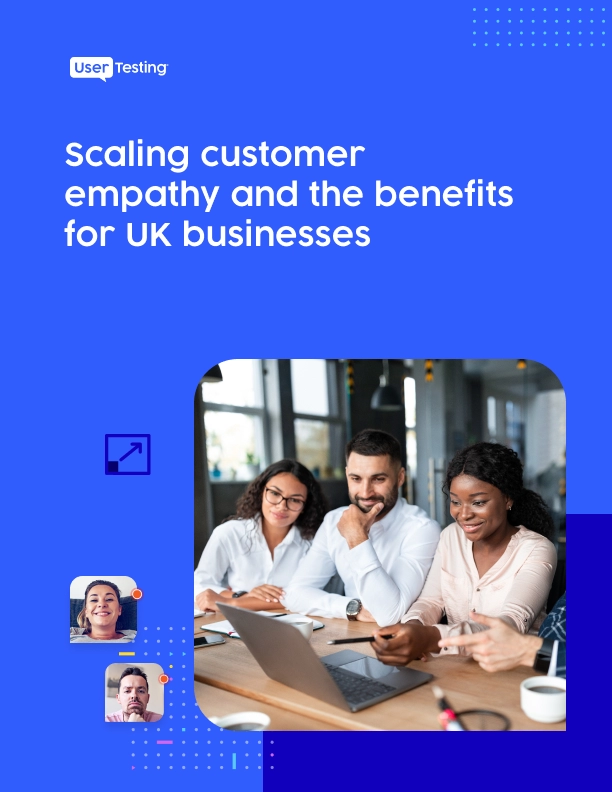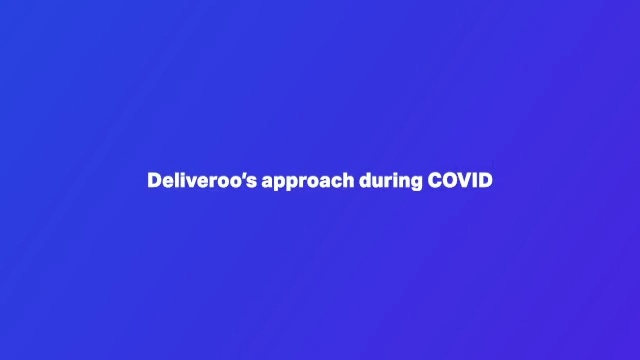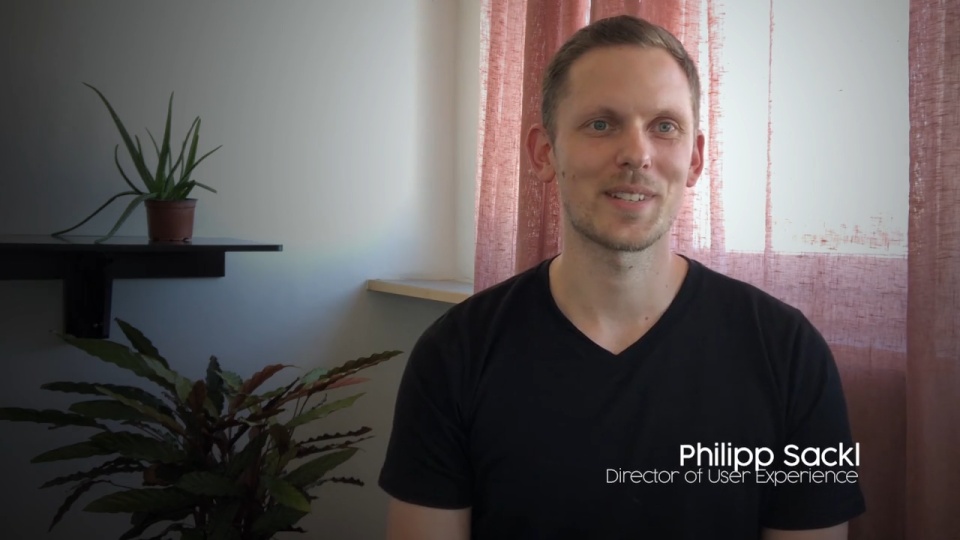
In this guide
Scaling customer empathy for UK businesses
Scaling customer empathy for UK businesses

Welcome to the age of the customer. Gone are the days of customer research being limited to a few individuals or a department. Today, the customer experience (CX) belongs to everyone. To compete in today’s evolving experience economy, companies need to empower everyone in their organisation to better understand their customers.
The “experience economy” is the changing landscape that we’re in. In this economy, companies compete against the best experience a customer has ever had. It’s a fundamental shift in how businesses go to market, influence their buyers, and engage with customers throughout their journey. In this world, experience trumps everything else. A customer’s loyalty goes to the experiences they crave—not products.
Your brand’s experience is made up of various touchpoints, interactions, and exposures that a consumer has with you, from products and services to marketing messaging and even employee interactions. In an experience economy, a brand must focus on building empathy and lasting relationships with its customers through an exceptional experience.
According to Capgemini, 75% of companies think they’re customer-centric, yet only 30% of their customers agree. We call this the empathy gap.

Narrowing this gap is critical. This can be done by connecting with customers and getting feedback on a regular cadence. To scale and optimize, companies must be able to take the insight they get and evangelise it across the organisation so that all employees have a shared understanding of the customer’s changing needs.
Companies that do this successfully have organisational buy-in. Their designers, marketers, and product managers—to name a few teams—are motivated and empowered to collect and share customer insights. Getting feedback is baked into their process.
How to scale CX insights

Once your organisation has committed to a customer-centered culture, you’re ready to start scaling customer research across your organisation. How a company scales its customer research practice will depend somewhat on the size, industry, and budget. There are, however, a few key steps that are universal to all organisations and a great way to establish a solid base for a growing CX practice.
Step 1: Empower non-researchers
While the desire may be there, one of the biggest challenges organisations face when scaling customer research is how to empower non-researchers to conduct their own research.
Even the word research can be intimidating. Teams unfamiliar with or even resistant to conducting their own research will need guidance and support to get them comfortable. Empower your non-researchers by:
- Show and tell - frequently share results from customer research
- 1:1 training - pair non-researchers with experienced researchers
- Conduct small, frequent studies - test with customers in small batches, often
- Do more with less - Utilize templates and save audiences
- Share results - share results from studies across the organisation
Step 2: Evangelise customer feedback
One of the most powerful motivators for a customer-obsessed company is hearing directly from customers. Whether you’re sharing with a colleague, your team, or the entire company, it’s important to highlight what you’ve discovered by interacting with customers.
Here are a few ways to keep the momentum going and inspire the entire company to continue collecting feedback:
- Host viewing parties - This is a fun activity that not only allows teams to share customer videos and results but gets everyone in the same room. It helps spark important discussions and create a shared understanding of the challenges at hand.
- Tell a story via video highlight reels - According to Accenture, only 32% of companies report realizing tangible and measurable value from data. Grab the attention of executives and other stakeholders with video feedback. While numbers and stats can depict trends, videos of customers telling their own stories are powerful and memorable.
- Make customer feedback part of team meetings - At UserTesting, every all-hands meeting starts with a compelling customer story. Try kicking off every team meeting with a clip or highlight reel from a recent study and open the discussion to see how those insights will impact the team’s strategy.
Step 3: Develop a healthy CX ecosystem
A healthy CX ecosystem has implemented a shared, scalable practice across the entire customer experience with all business goals centered around the customer. Each team, department, and individual is a vital element to the overall health—and success—of the customer-centered ecosystem.
After over a decade of working with the world’s leading brands to build and scale their CX practices, the teams at UserTesting have discovered key traits that strong CX leaders share. Companies that put their customers at the center of everything they do have a well-developed culture of creating great experiences and place a high value on understanding customers.

Scaling customer research across different teams
Every team within an organisation will leverage customer feedback in different ways. If your team is getting started with integrating customer insights into your strategy, it can be helpful to see how other teams rely on feedback to create better experiences for their customers.

How design teams scale customer research
Design sprints are one of the fastest ways to help design teams answer critical business questions using design thinking and customer validation. When teams incorporate on-demand customer research during sprints they can quickly gather valuable insights that inform design decisions while helping expose a team to design thinking and rally an entire organisation around the customer.
Here’s an example of how you can scale customer research as part of your design process:
- Setting the stage - in the weeks before you run the sprint, be sure to run tests with target customers to learn more about their needs.
- Design sprint week - validate the prototype or concepts with target customers.
- Turning ideas into reality - take the idea from prototype to working code by gathering insights from customers as you iterate and build.
When The Stars Group, a global leader in online and mobile gaming and interactive entertainment industries, wanted to expand their global footprint and improve their efficiency, they needed a solution that could scale. With UserTesting, the company created a standardized process for connecting with customers and getting feedback in a holistic way. After identifying numerous ways to create a more personalized customer experience, they reshaped their process to make discoveries like these priority. They even host internal competitions to see who can come up with the best ideas to improve their CX.
"With UserTesting, it is so much quicker to gain insights and deliver a best-in-class experience for our customers."
Daryn Hobden
Department Head, UX Architecture, The Stars Group
How research teams scale customer research
Research teams are naturally positioned to embrace customer research but scaling it takes a few extra steps. Research teams can have a maximal impact by teaming up with other disciplines to help uncover the most interesting and impactful challenges to explore.
Because research teams are experienced researchers, they’re in the unique position to conduct more in-depth customer research and then share their methodology for others within the organisation to adopt. For example, research teams can help other teams adopt customer research as part of their regular process by helping them:
- Know which research method to use
- Access existing data
- Recruit participants
- Get feedback
- Analyse the results
- Create templates for customer research studies
When Deliveroo first adopted UserTesting, it was to help their research team do more with less. Over time, they found themselves adapting the platform to meet other needs. They empowered non-research teams to conduct their own tests, used the platform to support strategic planning, and conducted remote research with their riders and restaurateurs. This meant their research team could maintain the high quality of their critical work, while supporting the broader needs of the company.

"My CEO praised my team for the speed and quality of our insights through UserTesting. The platform gives us clear decisions in less than a day."
Lydia Howland
Head of User Research, Deliveroo
How product teams scale customer research
Product managers are dually tasked with delighting customers but also growing the business. As a result, product decisions need buy-in from key stakeholders, and they need to be made faster than ever before.
Embedding regular customer feedback drives and informs product discovery and validation, helping teams make decisions quickly and confidently.
When dealing with time-to-market constraints while developing their app, Your.MD needed to quickly verify initial concepts to see if they resonated with their audience. They found that certain features did not and, fortunately, were able to make the necessary adjustments before it had a negative impact. At the same time, they discovered some of their messaging was misleading and confusing to people in the U.S. market. However, after quickly making the updates, they saw an increase in app downloads and retention.
"UserTesting has given us invaluable, instant insights into our customers."
Justin Berkovi
Chief Product Officer, Your.MD
How marketing teams scale customer research
Marketers can leverage customer insights to validate a huge array of marketing content—everything from commercials to images to email messages. It can also help you get inside customers' heads on a wide variety of topics, even sensitive subjects like religion and politics. Everyone from the social media manager to the direct-mail team should be listening to customers to understand what’s relevant to them. If you want a fast path to empathy with your customers, this is it.
The key to successful customer research that fits within an agile marking approach is threefold:
- Think small - don’t try to understand everything there is to know all at once. Instead, break it up, start with key objectives, iterate, then ask more questions.
- Be timely - make sure the research is conducted when there is still time to use it. Conduct research early and often so potential issues can be flagged and addressed before a campaign is launched.
- Empower everyone - from the social media manager to the direct-mail team, let your team listen to customers to understand their needs and how it relates to their own work.

The benefits of scaling customer research

If your company hasn’t yet embraced customer research across the organisation, it’s important to understand the benefits of incorporating customer insight into your business processes:
1. Discovery
Determine what to build next, supplement business strategy, usage analysis, and your instinct, with deep-dive customer and prospective customer interviews. These interviews will provide you with a prioritised list of the most important unmet needs, and even help inform you about the size of the market.
2. Design and build
When you have a clear understanding of the problem that you’re trying to solve, start by showing concepts to the target customer. These could be static images, landing pages, written descriptions, or marketing collateral. This helps you narrow down the feature set and value proposition. As you increase your understanding and fidelity of your solution, continue to test prototypes, both for usability, understandability, and value. When you’re close to launching a new product, test the live code with customers and run betas.
3. Launch and evaluation
Once a product or campaign has launched, track usage and customer feedback. Early on, you might spend more time in 1:1 follow-up interviews with customers to learn more. You may also consider conducting usability testing of the live product with people who have and haven’t had a chance to use it. This leads to incremental improvements or feeds into the discovery phase of a new product that you might build.
4. Organisational buy-in
At every company, there will always be lots of opinions. Regular customer insights will help support and drive decisions. Additionally, if you can show that you tested your assumptions and believe that something you thought would work won’t, people are much more likely to listen.
5. Teams are set up for success
While most organisations would likely love to staff their teams with enough researchers that they could perform all the activities described above, few can. That’s a good thing. Expanding customer research to other teams keeps everyone closer to customers. Teams that have their pulse on customer wants and needs are in a much better position to deliver better experiences.
6. Build better products
Scaling customer research to everyone in the organisation means fast customer insights and more of them. Those insights lead to launching more product improvements and informing what to build next.
When an entire organisation has access to customer insights, teams will have more confidence to move forward with ideas, not to mention saving time and money by not having to redo work that missed the mark.
Move faster |
Pivot in a global market |
Optimize for different groups of customers |
| With UserTesting, the Freeletics team creates and analyzes tests faster and more efficiently. They've reduced the complexity of their recruiting, planning, and collecting process which leaves them with more time to find out what their customers really want and why. | With UserTesting, Skyscanner developed a framework for understanding their global customer base faster and with greater confidence. Knowing "the why" behind customer actions, empowers their teams to make decisions like a startup. | Finastra’s financial services tool is used by 90 of the world’s top 100 banks, so they have an extensive testing roadmap. Finastra shares video feedback from UserTesting company-wide during agile sprints, which allows for rapid iteration and scale. |
The age of the customer demands a scaled customer research strategy
Today, more than ever, customers are driving how companies innovate and evolve. Gathering customer feedback a few times a year isn’t good enough. To meet the needs of today’s sophisticated customers, companies need to prioritise customer research as a necessary part of every team’s process and empower every employee to participate.



